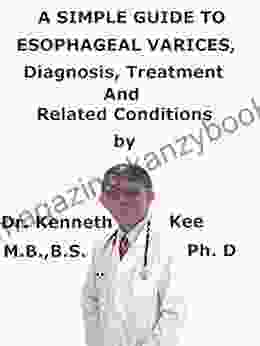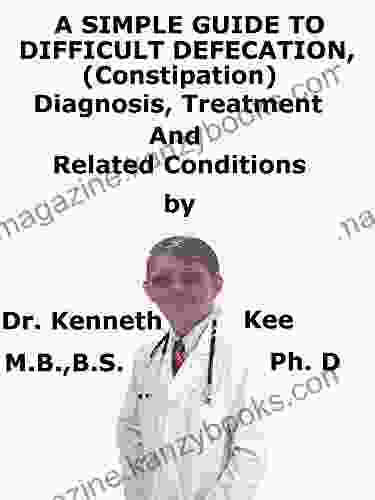Simple Guide to Esophageal Varices: Diagnosis, Treatment, and Related Conditions

5 out of 5
| Language | : | English |
| File size | : | 442 KB |
| Text-to-Speech | : | Enabled |
| Screen Reader | : | Supported |
| Enhanced typesetting | : | Enabled |
| Print length | : | 140 pages |
| Lending | : | Enabled |
Esophageal varices are enlarged veins in the esophagus that can cause bleeding. This guide provides a comprehensive overview of esophageal varices, including diagnosis, treatment options, and related conditions.
What are Esophageal Varices?
Esophageal varices are enlarged veins in the esophagus. The esophagus is the tube that connects the mouth to the stomach. Esophageal varices are caused by increased pressure in the veins of the esophagus. This pressure can be caused by a number of factors, including:
- Liver disease
- Portal vein thrombosis
- Budd-Chiari syndrome
- Splenic vein thrombosis
- Constrictive pericarditis
Esophageal varices can be a serious condition because they can bleed. Bleeding from esophageal varices can be life-threatening. The risk of bleeding is highest in people with large varices.
Symptoms of Esophageal Varices
The most common symptom of esophageal varices is bleeding. Bleeding from esophageal varices can be mild or severe. Mild bleeding may only cause a small amount of blood in the vomit or stool. Severe bleeding can be life-threatening.
Other symptoms of esophageal varices include:
- Difficulty swallowing
- Chest pain
- Abdominal pain
- Nausea
- Vomiting
- Fatigue
- Weight loss
Diagnosis of Esophageal Varices
Esophageal varices can be diagnosed with a variety of tests, including:
- Upper endoscopy
- Esophageal manometry
- Computed tomography (CT) scan
- Magnetic resonance imaging (MRI) scan
Upper endoscopy is the most common test used to diagnose esophageal varices. During an upper endoscopy, a thin, flexible tube with a camera on the end is inserted into the esophagus. The camera allows the doctor to see the inside of the esophagus and look for varices.
Treatment of Esophageal Varices
The goal of treatment for esophageal varices is to prevent bleeding. Treatment options include:
- Medication
- Endoscopic therapy
- Surgery
Medication can be used to reduce the pressure in the veins of the esophagus. This can help to prevent bleeding. Endoscopic therapy involves using a variety of techniques to treat esophageal varices. These techniques include:
- Band ligation
- Sclerotherapy
- Endoscopic variceal ligation
Band ligation is the most common endoscopic therapy for esophageal varices. During band ligation, a small rubber band is placed around the base of the varices. The band cuts off the blood supply to the varices, causing them to shrink and eventually disappear.
Sclerotherapy involves injecting a solution into the varices. The solution causes the varices to scar and shrink.
Endoscopic variceal ligation is a newer technique that involves placing a small metal clip around the base of the varices. The clip cuts off the blood supply to the varices, causing them to shrink and eventually disappear.
Surgery may be necessary to treat esophageal varices that are large or that have bled. Surgery involves removing the varices or creating a new pathway for blood to flow through the liver.
Related Conditions
Esophageal varices are often associated with other conditions, including:
- Liver disease
- Portal vein thrombosis
- Budd-Chiari syndrome
- Splenic vein thrombosis
- Constrictive pericarditis
Liver disease is the most common cause of esophageal varices. Liver disease can lead to increased pressure in the veins of the esophagus, which can cause varices to develop.
Portal vein thrombosis is a blood clot in the portal vein. The portal vein is the vein that carries blood from the intestines to the liver. Portal vein thrombosis can lead to increased pressure in the veins of the esophagus, which can cause varices to develop.
Budd-Chiari syndrome is a rare condition that occurs when the hepatic veins are blocked. The hepatic veins are the veins that carry blood from the liver to the heart. Budd-Chiari syndrome can lead to increased pressure in the veins of the esophagus, which can cause varices to develop.
Splenic vein thrombosis is a blood clot in the splenic vein. The splenic vein is the vein that carries blood from the spleen to the liver. Splenic vein thrombosis can lead to increased pressure in the veins of the esophagus, which can cause varices to develop.
Constrictive pericarditis is a condition in which the pericardium, which is the sac that surrounds the heart, becomes thickened and scarred. Constrictive pericarditis can lead to increased pressure in the veins of the esophagus, which can cause varices to develop.
Esophageal varices are a serious condition that can lead to bleeding. The risk of bleeding is highest in people with large varices. Treatment for esophageal varices aims to prevent bleeding. Treatment options include medication, endoscopic therapy, and surgery.
If you have any of the symptoms of esophageal varices, it is important to see a doctor right away. Early diagnosis and treatment can help to prevent serious complications.
5 out of 5
| Language | : | English |
| File size | : | 442 KB |
| Text-to-Speech | : | Enabled |
| Screen Reader | : | Supported |
| Enhanced typesetting | : | Enabled |
| Print length | : | 140 pages |
| Lending | : | Enabled |
Do you want to contribute by writing guest posts on this blog?
Please contact us and send us a resume of previous articles that you have written.
 Book
Book Novel
Novel Page
Page Chapter
Chapter Text
Text Story
Story Genre
Genre Reader
Reader Library
Library Paperback
Paperback E-book
E-book Magazine
Magazine Newspaper
Newspaper Paragraph
Paragraph Sentence
Sentence Bookmark
Bookmark Shelf
Shelf Glossary
Glossary Bibliography
Bibliography Foreword
Foreword Preface
Preface Synopsis
Synopsis Annotation
Annotation Footnote
Footnote Manuscript
Manuscript Scroll
Scroll Codex
Codex Tome
Tome Bestseller
Bestseller Classics
Classics Library card
Library card Narrative
Narrative Biography
Biography Autobiography
Autobiography Memoir
Memoir Reference
Reference Encyclopedia
Encyclopedia Kevin J Todeschi
Kevin J Todeschi Tina Muir
Tina Muir Michael Ezeanaka
Michael Ezeanaka Sandra Mendelson
Sandra Mendelson Kenneth Womack
Kenneth Womack Stephanie Niemis
Stephanie Niemis Sheridan Voysey
Sheridan Voysey Paul Selig
Paul Selig Samuel Erskine
Samuel Erskine Stacey Agdern
Stacey Agdern Mia Munro
Mia Munro Shelly Westerhausen
Shelly Westerhausen Nicky Corbishley
Nicky Corbishley Kevin L Michel
Kevin L Michel Samuel Tristan Ludlow
Samuel Tristan Ludlow Steve Bivans
Steve Bivans Your Crazy Uncle
Your Crazy Uncle Kim Mcdevitt Rd
Kim Mcdevitt Rd Len Tau
Len Tau Lori Jo Mccullough
Lori Jo Mccullough
Light bulbAdvertise smarter! Our strategic ad space ensures maximum exposure. Reserve your spot today!

 David Foster WallaceUnveiling the Epic Saga of "Mila 18" by Leon Uris: A Journey Through Time,...
David Foster WallaceUnveiling the Epic Saga of "Mila 18" by Leon Uris: A Journey Through Time,... Billy FosterFollow ·19k
Billy FosterFollow ·19k Efrain PowellFollow ·6.8k
Efrain PowellFollow ·6.8k Gene PowellFollow ·13.6k
Gene PowellFollow ·13.6k Braeden HayesFollow ·12.4k
Braeden HayesFollow ·12.4k Chance FosterFollow ·2.7k
Chance FosterFollow ·2.7k Anthony BurgessFollow ·3.5k
Anthony BurgessFollow ·3.5k Alvin BellFollow ·3.1k
Alvin BellFollow ·3.1k Israel BellFollow ·15.7k
Israel BellFollow ·15.7k

 Ernesto Sabato
Ernesto SabatoLoving Table: Creating Memorable Gatherings
Gatherings...

 Mark Twain
Mark TwainLifestyle After Cancer: The Facts
Cancer is a life-changing...

 Keith Cox
Keith CoxUnlocking the Nutritional Needs of Individuals with...
Individuals with physical disabilities...

 Rubén Darío
Rubén DaríoHandbook And Guide To Evaluation And Treatment
Empowering Healthcare...

 Andy Hayes
Andy HayesUnveiling the Truth: "Garden Myths" by Robert Pavlis...
The world of gardening is often filled with a...
5 out of 5
| Language | : | English |
| File size | : | 442 KB |
| Text-to-Speech | : | Enabled |
| Screen Reader | : | Supported |
| Enhanced typesetting | : | Enabled |
| Print length | : | 140 pages |
| Lending | : | Enabled |












